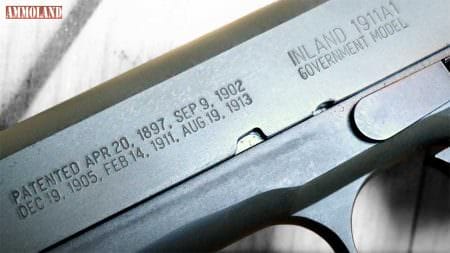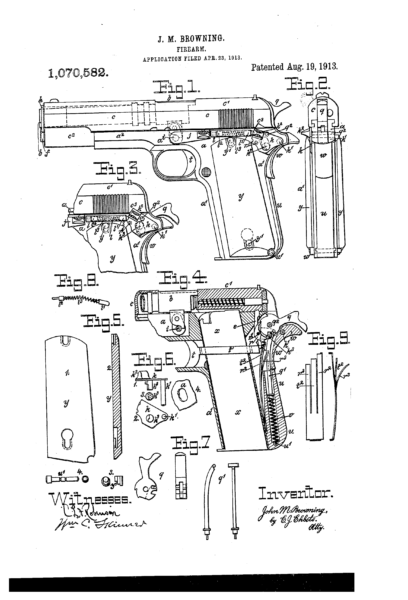
United States – (AmmoLand.com)- If you take a look at an older Colt 1911 slide that has patent dates listed on it, you’ll see that the most recent one is 116 years old, dating to August 19, 1913. On that day, US patent 1,070,582 was issued to John Moses Browning for improvements on his original M1911 patent from February 14, 1911.
Most people have probably looked right past the patent numbers on the slide. Of the few that have paid attention to them, a decidedly smaller number have had enough interest to look them up and see why each was necessary. So why, then, was it necessary for Browning to alter his design just two short years after introducing it?
Browning explains in his application that these changes were necessitated by the fact that “active military service makes it at times necessary” to carry the gun cocked and unlocked (in today’s parlance) while still being safe enough to prevent negligent discharge but, at the same time, ready to fire without any additional manipulation beyond what is required to grip the gun.
Visibly, guns made before this 1913 patent was issued are really no different than those made after it. Internally, however, are some important differences that have been present on all 1911s from then on to today.
In his patent application, Browning notes that the intention was to simplify the pistol by providing “improved construction” of some parts which would, in turn, allow each of them to “perform several distinct functions.” This would reduce the overall number of parts in the gun and – most importantly – “the entire arm may be assembled or dismounted without requiring the use of any tools.”

There are eight full pages of text in tiny type that explain everything he altered and why. To go over it all would be torture, so we’re only going to look at a couple of them. Essentially, Browning redesigned the grip and frame safety, simplifying their internal design and multi-function while still maintaining their intended purpose. Browning noted that this “manually operated combined slide-lock and hammer-lock” would now make the gun “positively safe against discharge” despite the condition in which the gun was being carried by soldiers in the field.
Most amusing, to me anyway, is that Browning refers to the military stipulations that required this alteration to be “necessary but contradictory.”
As for making the parts pull double-duty and allowing the gun to be disassembled without any tools, one of the ways this was accomplished was by simply redesigning the spring and its housing in between the frame safety and the slide lock. By allowing the now-slightly-bent spring to essentially hold itself in tension between the safety and lock, Browning was able to eliminate a locking pin and frame stud. Fewer parts meant faster production, less cost, and easier assembly and disassembly.
Delving into the text of old patent documents can be tedious at times, but it can also be very rewarding. I happen to enjoy connecting the dots between related patents and, in this case, tracking how their improvements led to the now-iconic M1911 design that we’ve all come to know.
About Logan Metesh
Logan Metesh is a historian with a focus on firearms history and development. He runs High Caliber History LLC and has more than a decade of experience working for the Smithsonian Institution, the National Park Service, and the NRA Museums. His ability to present history and research in an engaging manner has made him a sought after consultant, writer, and museum professional. The ease with which he can recall obscure historical facts and figures makes him very good at Jeopardy!, but exceptionally bad at geometry.


Yep, as far as I am concerned, there is no finer fighting hand gun on the planet. Plenty enough power for the task it was created for. It “fits” well on one’s side, under the belt for those times when a holster is too much. For those who want higher capacity, there are 14 round models. For those who want different calibers you can find them in 22 lr, 380, 9mm, 40 S & W, 10 mm, 38 super and others. Once one has learned how to shoot one accurately and rapidly it is a force to be reckoned with.… Read more »
Still have a 70 Series from 75-76….on its second Bar-Sto barrel. I have a lot of pistols..but, if I have to walk outside and put myself in harms way with a sidearm…this Colt is what I would take…
I enjoyed your article as far as it went, but I really wish that you had fleshed it out a bit on the explanatory side of things, pertaining to the changes from a military perspective.
I too found great joy in securing and researching primary sources, which were much more rewarding than going through reams of secondary sources!
Thank you for your efforts and your time and I look forward to reading more of your work.